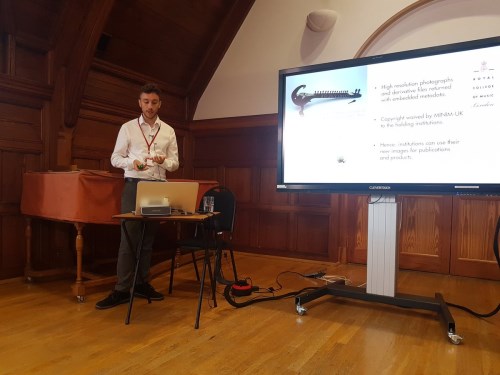We are delighted to share the presentations from the symposium, with thanks to the speakers and all involved with the development of the conference.
Keynote - Sonic Objects in Museums: A Philosophical Turn
Eric de Visscher, Andrew W.Mellon Visiting Professor at Victoria and Albert Museum Research Institute.
MINIM-UK
Gabriele Rossi Rognoni and Richard Martin, Royal College of Music.A virtual museum featuring 20,000 instruments from 200 of the UK’s musical instrument collections, on a platform that takes advantage of the interactive context of musical instruments, and ‘siloing’ the approach to cataloguing for maximum local impact.
MIMO (Musical Instrument Museums Online)
Rodolphe Bailly, Philharmonie de Paris.The development of the MIMO project, unlocking musical instrument collections from across Europe.
Art UK
Katey Goodwin.Art UK have been digitising artworks in public collections for 15 years, to help provide greater access to the art we all own. Having catalogued all the oil paintings in public ownership in the UK, they are now embarking on a major project to digitise the nation's sculpture, both in our public collections and outside in our streets and parks. Project Manager for the sculpture project, Katey Goodwin, explains how Art UK is approaching this ambitious initiative.
Europeana
Tom Miles, The British Library.An overview of the Europeana Sounds project that ran from 2014 to 2017, and a look at Europeana Music which was developed and launched during the project.
LOLA and networked performance
Matt Parkin, Royal College of Music.LOLA low latency technology helps students at the RCM make music in real-time with musicians all over the world, and is being used to research how musicians interact and build relationships at a distance without meeting, in an ongoing project led by Dr Tania Lisboa entitled Rehearsing and performing in cyber space: a focus on communication and interaction. How could this technology be used to link important historic instruments?
LITMUS: Linked Irish Traditional Music
Lynnsey Weissenberger, Irish Traditional Music Archive.LITMUS is a 2-year Horizon2020 project at the Irish Traditional Music Archive working to build a linked data ontology to better express what occurs within oral transmission, focusing on Irish traditional music and dance.
Google Arts and Culture
Natasha David and Suhair Khan.Presenting the Google platform for dissemination of cultural heritage information.
Victoria and Albert Museum
Marta Ajmar and Marion Crick.An overview of current works at VARI, the museum's research institute, and its Content / Data / Object project.
Tudor Partbooks
Julia Craig McFeely, University of Oxford.The Tudor Partbooks project undertook the reconstruction of two partbook sets that are currently unusable, one because of the loss of one of the books, and the other (the subject of this paper) badly damaged by acid burn-through. The paper discusses the decisions behind the techniques employed in the digital repair work on the Sadler Partbooks (GB-Ob Mus.e.1–5), and the often complex process of forensic reconstruction of the books to a point where they can now be read in their entirety and studied paleographically.
MUSICES, and 3D scanning of instruments
Frank Bär, Germanisches Nationalmuseum.The project MUSICES – Musical Instrument Computed Tomography Examination Standard – was funded by the German Research Association (DFG) and was carried out by Germanisches Nationalmuseum in Nuremberg and Fraunhofer Development Center for X-Ray Technology in Fürth with support from national and international partners. The project’s aim was the development of Recommendations for the 3D-CT of musical instruments and other cultural assets, in order to make this technology better accessible for research. The talk describes the project, its achievements and a sneak preview of the MUSICES website where all data can be retrieved.
Arvedi Laboratory for Non-invasive Diagnostics at the Violin Museum of Cremona
Piercarlo Dondi, University of Pavia.The presentation focusses on the use of image processing and 3D modelling techniques for the study of historical violins. Results of the analyses conducted on 17th - 18th century instruments held in Museo del Violino of Cremona (Italy) are presented, with some examples of Human-Computer interaction applications designed for scientific dissemination.

